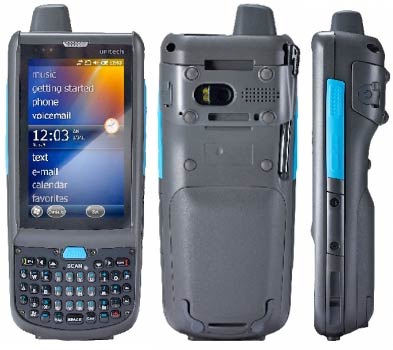Unitech launched the PA690 mobile computer in July of 2011 as a rugged outside-the-four-walls device designed to assist mobile workforces in today's competitive business environment. Equipped with a large and exceptionally sharp sunlight-readable display and numerous data collection options and wireless communication options, the PA690 has a lot of qualities that help it to up the ante in this competitive field.

From a hardeware perspective, the PA690 is a powerful and advanced machine. It is based on the 806MHz version of the Marvel PXA320 processor, which is still the most potent and versatile XScale processor ever. There's the usual 256MB of RAM and 512MB of Flash needed to run Windows Embedded Handheld 6.5 Professional or Classic. Storage can be augmented via a microSDHC Card slot. The standard battery packs 8.14 watt-hours, but we suggest the optional 14.8 watt-hour extended battery.
Very impressive is the PA690's large 3.8-inch transflective display with 480 x 800 pixel resolution, higher than virtually all Windows CE/Mobile handhelds. This means a sharper image and more screen real estate for complex applications. The PA690 also has a 5-megapixel autofocus camera with flash that can also record VGA MPEG-4 video.
The 690 can also be ordered with either one of two very different keypads. The standard 26-key arrangement includes the usual function keys and numeric keypad. An also available 44-key keypad includes numeric, alpha and function keys. It looks like a Blackberry-style thumb-type keyboard with a standard QWERTY layout. Each version has four navigation keys, a scan key, phone pickup and hangup keys, and the usual Windows CE/Mobile auxiliary keys.
The device is hugely configurable for data collection tasks. Customers can go with the standard 1D laser scanner (UPC-A/E, EAN-8/13, Codabar, Code 39, Code 39 full ASCI, Code 93, Code 32, Interleaved & Std. 2 of 5, EAN 128, Code 11, Delta, MSI/Plessey, Code 128, and Toshiba), or with a 2D imager (Aztec, Codablock F, Code 49, Datamatrix, EAN-UCC, composite, Maxicode, Micro PDF417, PDF 417, QR code, Tcif lonked C39). Also available is a 13.56MHz RFID reader with ISO15693, ISO14443A and ISO14443B tag support. For location based services there is a u-blox 6 high-performance GPS chipset that also supports the European GALILEO satellite system.
On the wireless communication side, there's 802.11 a/b/g WiFi, Bluetooth 2.1 with enhanced data rate, as well 3.5G WWAN for wide area cellular voice and data connections. And there are dual external antennas for best possible WWAN and WLAN wireless connectivity and performance.
For a device this powerful with such a high resolution display and full keyboard, the PA690 is quite compact, measuring 2.9 x 7 x 1.6 inches, and weighing under 14 ounces with the standard battery. The design seems ergonomic with emphasis on making it easy to hold and operate.
A word about the operating system: at a time where most consumer smartphones use either Android or the Apple iOs, and even Microsoft-powered phones use Windows Phone 7 which is not compatible with earlier versions of Windows CE or Windows Mobile, Unitech's choice of Windows Embedded Handheld 6.5 Professional (which is really a renamed Windows Mobile 6.5) may seem odd. It's not. For better or worse, for now Windows CE and Windows Mobile continue to be the platform of choice for vertical market and industrial handhelds. There's just too much Windows Mobile business software out there, as well as all the application development expertise, software tools, and leverage that comes from fitting right into corporate IT systems.
As far as ruggedness goes, the Unitech PA690 delivers as well. 5-foot drop spec, IP65 sealing where the "6" means the device is fully dustproof, and the "5" that it can handle low pressure water jets from all directions. There's also a wide 14 to 122 degree Fahrenheit operating temperature range, and presumably a slew of other tests and certifications.
The PA690 is a very nice piece of hardware that combines an awful lot of functionality, and it looks like a very strong contender for anyone seeking an advanced combination of rugged mobile computer, industrial smartphone, and data capture device.
Unitech America is a subsidiary of Taiwanese automatic data collection specialist Unitech, founded in 1979. They are also one of the largest manufacturer of rugged PDAs.



